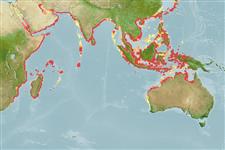>
Eupercaria/misc (Various families in series Eupercaria) >
Nemipteridae (Threadfin breams, Whiptail breams)
Etymology: Scolopsis: Greek, skolex = worm + Greek, opsis = appearance (Ref. 45335); vosmeri: Name from the acronym of the Indira Gandhi Centre for Atomic Research (IGCAR), Kalpakkam, where it was first collected..
More on author: Bloch.
Environment: milieu / climate zone / depth range / distribution range
Ecologia
marino associati a barriera corallina; distribuzione batimetrica 2 - 25 m (Ref. 9710). Tropical
Indo-West Pacific: from the Red Sea and East Africa to Pakistan, India, Sri Lanka, Bangladesh, Myanmar and Thailand (Andaman Sea), extending to western Indonesia and Borneo, the Philippines and New Guinea (Also Ref. 120578).
Size / Peso / Age
Maturity: Lm ? range ? - ? cm
Max length : 25.0 cm TL maschio/sesso non determinato; (Ref. 4427); common length : 15.0 cm SL maschio/sesso non determinato; (Ref. 3810)
Spine dorsali (totale): 10; Raggi dorsali molli (totale): 9; Spine anali 3; Raggi anali molli: 7; Vertebre: 22. This species is distinguished by the following set of characters: scaly temporal region with scales on top of head reaching forward to just in front of the anterior nostrils; naked suborbital; the lower margin of the eye is tangent to or just above a line from snout tip to upper pectoral-fin base; exposed bony ridge below the eye with an antrorse and retrorse spine; scales on preopercle are extending to posterior margin, scales behind suborbital 5-6 rows and behind eye 3-4 rows; the lower limb of preopercle usually has a single row of embedded scales; scales on opercle 4-7 rows; most body scales (except for caudal peduncle) have a black spot; caudal peduncle white; usually a white band is present beneath lateral line, from origin of lateral line to below posterior part of dorsal fin; from nape onto operculum is a broad white bar, and suborbital with distinctive white patch - all these not present in juveniles and smaller subadults; upper limb of opercular margin narrowly brown, the lower limb narrowly reddish-orange; upper base of pectoral fin with a small dark spot; pelvic and anal fins are crimson or orange-red (Ref. 120656).
Benthic in inshore turbid or weedy waters, usually on sand or mud or rubble bottoms close to reefs (Ref. 30573, 90102, 92980), as well as offshore areas (Ref. 9785). Seen solitary, but may school deep (Ref. 48635). Feeds on benthic organisms (Ref. 5213). Marketed fresh, salted, smoked or processed into fish balls (Ref. 12484).
Life cycle and mating behavior
Maturità | Riproduzione | Deposizione | Uova | Fecundity | Larve
Russell, B.C., 1990. FAO Species Catalogue. Vol. 12. Nemipterid fishes of the world. (Threadfin breams, whiptail breams, monocle breams, dwarf monocle breams, and coral breams). Family Nemipteridae. An annotated and illustrated catalogue of nemipterid species known to date. FAO Fish. Synop. 125(12):149p. Rome: FAO. (Ref. 3810)
IUCN Red List Status (Ref. 130435)
Threat to humans
Harmless
Human uses
Pesca: commerciale; Pesce da pesca sportiva: si
Informazioni ulteriori
Nomi ComuniSinonimiMetabolismoPredatoriEcotossicologiaRiproduzioneMaturitàDeposizioneSpawning aggregationFecundityUovaEgg development
BibliografiaAcquacolturaProfilo di acquacolturaVarietàGeneticaElectrophoresesEreditarietàMalattieElaborazioneNutrientsMass conversion
Strumenti
Special reports
Download XML
Fonti Internet
Estimates based on models
Preferred temperature (Ref.
123201): 25.4 - 29.3, mean 28.6 °C (based on 2454 cells).
Phylogenetic diversity index (Ref.
82804): PD
50 = 0.5000 [Uniqueness, from 0.5 = low to 2.0 = high].
Bayesian length-weight: a=0.01514 (0.00834 - 0.02746), b=3.03 (2.88 - 3.18), in cm total length, based on LWR estimates for this species & Genus-body shape (Ref.
93245).
Trophic level (Ref.
69278): 3.5 ±0.37 se; based on food items.
Resilienza (Ref.
120179): Alto, tempo minimo di raddoppiamento della popolazione meno di 15 mesi (Preliminary K or Fecundity.).
Fishing Vulnerability (Ref.
59153): Low vulnerability (15 of 100).
Nutrients (Ref.
124155): Calcium = 64 [40, 132] mg/100g; Iron = 0.686 [0.339, 1.648] mg/100g; Protein = 19 [17, 21] %; Omega3 = 0.144 [0.087, 0.239] g/100g; Selenium = 26.1 [15.3, 47.0] μg/100g; VitaminA = 78.8 [22.0, 230.3] μg/100g; Zinc = 1.35 [0.93, 1.95] mg/100g (wet weight);
